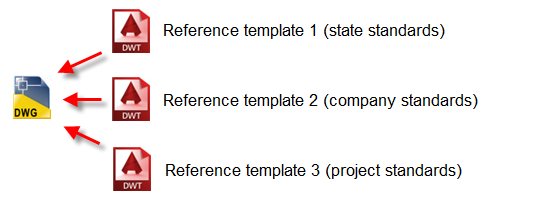You can use reference templates to manage styles, settings, layers, and other standard drawing components.
You can attach one or more reference templates to an Autodesk Civil 3D drawing so it will be updated on an ongoing basis with changes to the referenced components in the templates.
You can reference the following components:
- Styles:
- Object styles
- Label styles
- Table styles
- Quantity takeoff criteria
- Pipe and structure rule sets
- Pressure network parts lists
Note: All expressions and alignment and profile design check sets are referenced by default. - Settings:
- Drawing Settings:
- Object layers
- Abbreviations
- Ambient settings
- Label style default settings
- Feature settings
- Drawing Settings:
- AutoCAD Layers
- AutoCAD blocks, text styles, and line types
- Property sets
Standard template process
When you create new a drawing based on a drawing template, the new drawing gets a copy of the styles and settings in the template, but it is a one-time copy. The connection is not maintained. In the past, if you updated the styles and settings in your template, and you wanted your drawings to get those same updates, you needed to manually copy or import those changed styles and settings into your drawings.
Reference template process
When you attach a reference template to a drawing, the referenced components (styles, settings, property sets, layers, blocks, text styles, and line types) that are in that reference template are copied into the drawing, and the connection between the drawing and the reference templates is maintained.
Then, on an ongoing basis, changes to the reference templates are pushed to the drawing so it is kept up to date:
- New or changed components in reference templates are copied to the drawing.
- Referenced components that are deleted from reference templates are removed from the drawing if they are not in use. If a component such as a style is in use, a local copy of it is made in the drawing.
In addition, you can have multiple reference templates attached to a drawing. For example, you might have templates for state, company, and project standards:

You can specify a hierarchy so that the template with the highest priority takes precedence if there are duplicate styles.
New or edited components that are saved to the reference templates are updated in the drawings when the drawings are reopened or when the templates are manually reloaded.
For example, if you update a style or add a new style to the project standards template, those changes are pushed to the drawings that reference that template.

You can be selective about which components you want to reference from a reference template. For example, if a template has ten point styles, you can choose to reference only the five that you want. You can also remove referenced components that have not been used. For more information, see To Work With Reference Templates.
Updating referenced components
After you attach a reference template to a drawing, referenced components should be edited in the source template rather than in the drawings to which the reference template is attached.
- For referenced Autodesk Civil 3D components: You are notified if you attempt to edit a referenced Autodesk Civil 3D component. If you edit a referenced style, for example, a task dialog box is displayed with choices you can make. You can save a copy of the style, keep the changes temporarily until the drawing is re-opened, or cancel the change.
- For referenced AutoCAD components: You are not notified if you attempt to edit a referenced AutoCAD component. If you edit a referenced AutoCAD component, the changes will be overwritten the next time the drawing is updated from the reference template.
Managing links to reference templates
If you open a drawing whose reference templates cannot be found, such as if they are on a network location that is not currently accessible, or if the reference templates are moved, renamed, or deleted, a Path Not Found notification is displayed in the Status column in the Attach Reference Templates dialog box:

If the reference template cannot be found, the referenced components are still available in the drawing that references them, but they will not be updated until the path is restored.
- If the name or location of the template has changed, you can change the path in the dialog box by directly editing the path in the Saved Path column or by using the browse button to reselect the template.
- If you are temporarily not able to access the path, the referenced components will still be available in the drawing that references them but they will not be updated until your connection to the path is restored.
- If the reference template has been deleted, the referenced components will remain in the drawing that references them.